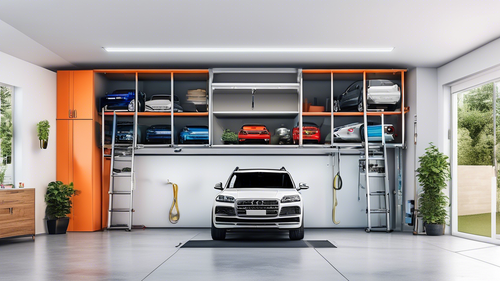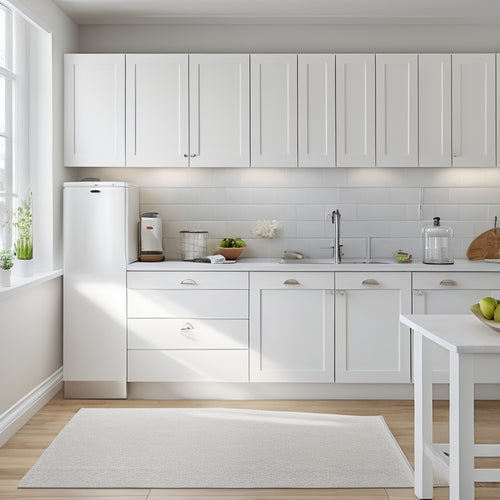
3 Stackable Container Hacks for a Tidy Pantry
Share
You can turn your pantry into a clutter-free haven by utilizing stackable containers in three clever ways. First, maximize your vertical storage space by installing shelving and using stackable bins to store dry goods, canned items, and essentials. Next, control clutter with divided containers that separate similar items, like different types of pasta, for easy access and meal prep. Finally, label your bins by type, expiration date, or usage frequency to facilitate quick identification and inventory management. With these hacks, you'll be just a step away from a pantry that's not only tidy but also functional, and there's more to investigate to take your pantry game to the next level.
Key Takeaways
- Stackable bins optimize storage for dry goods, canned items, and essentials, maximizing vertical space and reducing clutter.
- Labeling bins by type, expiration date, or usage frequency enhances organization and facilitates quick identification of contents.
- Divided containers prevent similar items from mixing, allowing for easy access to different items and maintaining order.
- Color coding labels effectively differentiates between various categories, improving visual appeal and readability.
- Innovative label fonts and "use by" dates help manage inventory and expiration awareness, promoting a tidy pantry experience.
Maximizing Vertical Storage Space
Frequently, homeowners struggle to fit all their pantry essentials into a compact space, leading to clutter and disorganization. You're not alone! Implementing effective organizational strategies, such as assigning specific homes for items, can help alleviate this issue.
One effective way to tackle this issue is by maximizing your vertical storage space. Installing vertical shelving is a great starting point, as it allows you to take advantage of the often-wasted space between the top of your pantry shelves and the ceiling.
Next, use stackable bins to store dry goods, canned items, and other essentials. Label each bin so you can easily find what you need.
Controlling Clutter With Divided Containers
About half of your pantry's clutter stems from similar items getting jumbled together, making it difficult to find what you need when you need it. To combat this, you can use divided bins to separate similar items into distinct categories.
For example, you can store different types of pasta in separate compartments within a single bin, making it easy to grab what you need for meal prep. This approach helps maintain order and prevents clutter from building up again.
Labeling for Easy Accessibility
With your divided containers in place, it's time to take your pantry organization to the next level by labeling each bin. This step is essential in maintaining a tidy pantry, as it allows you to quickly identify what's inside each container.
You can use labels to categorize items by type, expiration date, or frequency of use.
Here's how to take your labeling to the next level:
- Color code your labels to differentiate between categories, such as baking supplies, snacks, or spices.
- Use innovative fonts to add visual interest and make your labels more readable.
- Consider adding a "use by" date or a "restock" reminder to guarantee you stay on top of expiring items.
Frequently Asked Questions
What Is the Best Material for Stackable Containers: Plastic, Glass, or Metal?
Life is a puzzle, and you're the expert builder; choosing the right material for your stackable containers is an essential piece. You'll find plastic is affordable but may compromise on durability, while glass guarantees material safety, and metal offers a sturdy middle ground, so pick wisely.
How Do I Prevent Containers From Toppling Over When Stacked?
When stacking, you'll want to perfect stacking techniques to guarantee container stability. You can achieve this by placing heavier containers at the bottom, aligning them centrally, and distributing weight evenly, which will prevent toppling and keep your storage organized.
Can I Use Stackable Containers for Storing Perishable Food Items?
You're probably thinking, 'Why bother with stackable containers if they'll just become a breeding ground for bacteria?' But fear not, friend! Choose airtight, moisture-resistant stackable containers made of BPA-free materials to keep perishable food items fresh and safe.
Do Stackable Containers Work Well for Storing Dry Goods Like Flour and Sugar?
You'll find that stackable containers are perfect for dry goods storage, keeping flour, sugar, and other essentials fresh and organized in your pantry, allowing you to maximize space and maintain a tidy pantry organization system.
How Often Should I Clean and Sanitize My Stackable Containers?
You should clean your containers every 1-2 months, or immediately after storing perishable items, and sanitize them quarterly using a mixture of water and vinegar to prevent bacterial growth and keep them fresh.
Related Posts
-

Can I Install a Car Lift in My Garage?
A Comprehensive Guide for Homeowners Envision the ultimate automotive sanctuary in your very own garage, where you...
-

10 Creative Cabinet Solutions for a Clutter-Free Kitchen
You're tired of cluttered kitchen cabinets making meal prep a hassle. Change your kitchen with 10 creative cabinet so...

